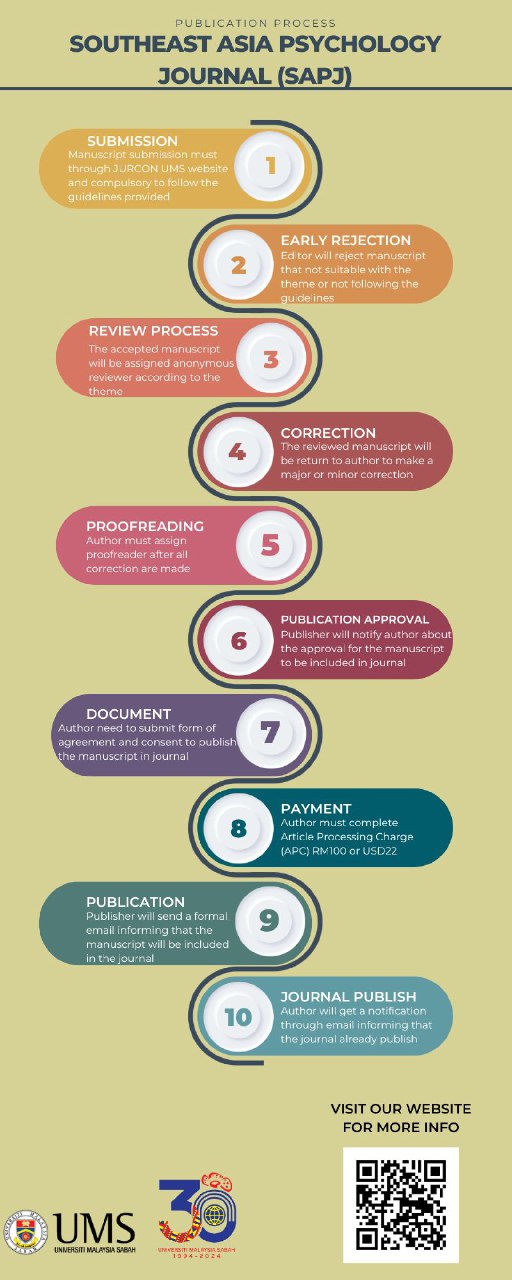PERCEPTIONS OF SINGAPORE ADOLESCENTS ON THE ROLES AND CHARACTERISTICS OF SCHOOL COUNSELLORS
DOI:
https://doi.org/10.51200/sapj.v9i1.4974Keywords:
Singapore School Counselling; Counsellors’ Roles; Counsellors’ CharacteristicsAbstract
School counselling has been implemented in all Singapore public schools for more than a decade. This study sought the perceptions of Singapore adolescents on the roles and characteristics of school counsellors. A survey was administered to 135 students from Nanyang Polytechnic. This research was largely descriptive in nature with one open-ended question. The results showed that adolescents had some misconceptions on the roles of school counsellors. An unanticipated finding revealed that adolescents who had not experienced the counselling process had better perceptions of the characteristics of a school counsellor. These results imply that school counsellors need to take on a more proactive role in reaching out to students, in terms of information sharing and creating awareness. Recommendations have been made for enhancing the school counselling landscape.
References
Bennet, E. D., Lindhal, K., Wharton, S., & Tin, W. N. (2017). Five Out of the Box Techniques for Encouraging Teenagers to Engage in Counseling. American Counseling Association. https://www.counseling.org/knowledge-center/vistas/by-subject2/vistas-children/docs/default-source/vistas/encouraging-teenagers
Binder, P., Moltu, C., Hummelsund, D., Sagen, S. H., & Holgersen, H. (2011). Meeting an adult ally on the way out into the world: Adolescent patients’ experiences of useful psychotherapeutic ways of working at an age when independence really matters. Counselling Research, 21, 554 – 566. https://doi.org/10.1080/10503307.2011.587471 Bond, T. (1992). Ethical Issues in Counselling in Education. British Journal of Guidance & Counselling, 20(1), 51–63. https://doi.org/10.1080/03069889208253609
Bryan, D. M., & Gallant, D. J. (2012). Some things are better left unsaid: African American male high school students’ perceptions of school counseling services. Journal of African American Males in Education, 3(1), 47–56. https://searchebscohostcom.libproxy.nie.edu.sg/login.aspx?direct=true&db=eue&AN=128699419&site=eds-live&scope=site
Choi, A. (2018). Emotional well-being of children and adolescents. OECD Education Working Papers. https://doi.org/10.1787/41576fb2-en
Church, E. (1994). The role of autonomy in adolescent psychotherapy. Psychotherapy: Theory, Research, Practice, Training, 31(1), 101–108.https://doi-org.libproxy.nie.edu.sg/10.1037/0033-3204.31.1.101
Duncan, B., Miller, S. D., & Sparks, J. (2007). Common factors and the uncommon heroism of youth. Counselling in Australia, 13(2), 34–43.
Fife, S. T., Whiting, J. B., Bradford, K., & Davis, S. (2014). The therapeutic pyramid: a common factors synthesis of techniques, alliance, and way of being. The Journal Of Marital And Family Therapy, 40(1), 20. https://doi.org/10.1111/jmft.1204
Fox, C., & Butler, I. (2007). ‘If you don’t want to tell anyone else you can tell her’: young people’s views on school counselling. British Journal of Guidance & Counselling, 35(1), 97–114. https://doi-org.libproxy.nie.edu.sg/10.1080/03069880601106831
Fegert, J. M., Vitiello, B., Plener, P. L., & Clemens, V. (2020). Challenges and burden of the Coronavirus 2019 (COVID-19) pandemic for child and adolescent mental health: A narrative review to highlight clinical and research needs in the acute phase and the long return to normality. Child and Adolescent Psychiatry and Mental Health, 14(1). https://doi.org/10.1186/s13034-020-00329-3
Gutgesell, M., & Payne, N. (2004). Issues of adolescent psychological development in the 21st century. Paediatrics in Review, 25(3), 79–85 Ho, K. (2019, November 23). A third of Singaporeans have experienced suicidal thoughts. YouGov. https://sg.yougov.com/en-sg/news/2019/06/25/sg-mentalhealth-selfharm/
Kehle, T. J., & Bray, M. A. (2003). Wampold, B. E. (2001). The great psychotherapy debate: Models, methods and findings. Mahwah, NJ: Lawrence Erlbaum, Publishers. Psychology in the Schools, 40(6), 701–702. https://doi.org/10.1002/pits.10115
Kok, J. K. (2013). The role of the school counsellor in the Singapore secondary school system. British Journal of Guidance & Counselling, 41(5), 530–543. https://doi-org.libproxy.nie.edu.sg/10.1080/03069885.2013.773286
Kuhn, L. A. (2004). Student perceptions of school counselor roles and functions (Master's thesis, University of Maryland, 2004). College Park, MD: University of Maryland. Larson, R. W. (2002). Globalization, societal change, and new technologies: What they mean for the future of Adolescence. Journal of Research on Adolescence, 12(1), 1. https://doi-org.libproxy.nie.edu.sg/10.1111/1532-7795.00023
Lee, B. O. (2006). Clients as co-healers. In H. W. E. Lui & S. S. Wong (Eds.), Reflections on counselling: Developing practice in schools (pp. 56-74). Singapore: Pearson Prentice Hall.
Lindsey, C. R., & Kalafat, J. (1998). Adolescents’ views of preferred helper characteristics and barriers to seeking help from school-based adults. Journal of Educational & Psychological Consultation, 9(3), 171. https://doi-org.libproxy.nie.edu.sg/10.1207/s1532768xjepc0903_1
Low, P. K. (2014). Looking in from the outside: community counsellors’ opinions and attitudes to school counselling in Singapore. Pastoral Care in Education, 32(4), 295–305. https://doi-org.libproxy.nie.edu.sg/10.1080/02643944.2014.974663
Low, P. K. (2015). School counselling in Singapore: teachers’ thoughts and perceptions. Asia Pacific Journal of Counselling & Psychotherapy, 6(2), 17. https://search-ebscohostcom.libproxy.nie.edu.sg/login.aspx?direct=true&db=edb&AN=110339658&site=eds-live
Ministry of Education. (2004). Parliamentary reply on school counsellors, by acting Minister of Education [Press release]. http://www.moe.gov.sg/media/parliamentaryreplies/2004/pq05012004.htm#School_Counsellors
Ministry of Education. (2021). Counselling and student welfare. Retrieved September 30, 2021 from https://www.moe.gov.sg/programmes/counselling-and-student-welfare
Nanyang Polytechnic (NYP). (n.d.). Prospectus. Retrieved September 30, 2021 from https://www.nyp.edu.sg/prospectus
Ohrt, J. H., Limberg, D., Bordonada, T. M., Griffith, C., & Sherrell, R. S. (2016). Adolescents’ perceptions of their school counselors’ impact. Journal of Child and Adolescent Counseling, 2(1), 1. https://search-ebscohostcom.libproxy.nie.edu.sg/login.aspx?direct=true&db=edo&AN=ejs38757868&site=eds-live&scope=site
Patel, V., Flisher, A. J., Hetrick, S., & McGorry, P. (2007). Mental health of young people: a global public-health challenge. The Lancet, 369 (9569), 13021313. https://doiorg.libproxy.nie.edu.sg/10.1016/S01406736(07)60368-7
Sackett, C. R., Farmer, L. B., & Moran, K. B. (2018). A phenomenological inquiry of high school students’ meaningful experiences with school counselors. Journal of School Counseling, 16(19), 1–31. https://search-ebscohostcom.libproxy.nie.edu.sg/login.aspx?direct=true&db=eue&AN=132550664&site=eds-live&scope=site Samaritans of Singapore (SOS) | Homepage. (2020). https://www.sos.org.sg/
Shimoni, A., & Greenberger, L. (2014). School counselors deliver information about school counseling and their work: what professional message is conveyed? Professional School Counseling, 18(1), 15. https://search-ebscohostcom.libproxy.nie.edu.sg/login.aspx?direct=true&db=edsgao&AN=edsgcl.408784074&site=eds-live&scope=site
Solmonson, L. L., Roaten, G. K., Jones, D. G., & Albrecht, A. C. (2014). College freshmen’s perceptions of high school counselors. Journal of Professional Counseling: Practice, Theory & Research, 41(1), 2–16. https://doi.org.libproxy.nie.edu.sg/10.1080/15566382.2014.12033929
Sonderen, E. V., Sanderman, R., & Coyne, J. C. (2013). Ineffectiveness of reverse wording of questionnaire items: let’s learn from cows in the rain. PLoS ONE, 8(7), 1–7. https://doi.org/10.1371/journal.pone.0068967 Suárez-Alvarez, J., Pedrosa, I., Lozano, L. M., García-Cueto, E., Cuesta, M., & Muñiz, J. (2018). Using reversed items in likert scales: A questionable practice. Psicothema, 30(2), 149–158. https://doi.org/10.7334/psicothema2018.33
Subramaniam, M., Abdin, E., Picco, L., Vaingankar, J. A., & Chong, S. A. (2014). Multiple chronic medical conditions: prevalence and risk factors — results from the Singapore Mental Health Study. General Hospital Psychiatry, 36(4), 375–381. https://doi-org.libproxy.nie.edu.sg/10.1016/j.genhosppsych.2014.03.002
Sullivan, E., Kehle, T. J., & Bray, M. A. (2009). Application of the contextual model to school-based counseling: Why does it work? Psychology in the Schools, 46(3), 299–305. https://doi-org.libproxy.nie.edu.sg/10.1002/pits.20376
Ursachi, G., Horodnic, I. A., & Zait, A. (2015). How reliable are measurement scales? External factors with indirect influence on reliability estimators. Procedia Economics and Finance, 20, 679-686.
Wampold, B. E. (2015). How important are the common factors in psychotherapy? An update. World Psychiatry, 14(3), 270-277. https://doi.org/10.1002/wps.20238 Yeo, L. S., Tan, S. Y., & Neihart, M. F. (2012). Counseling in Singapore. Journal of Counseling & Development, 90(2), 243-248. https://doi.org/10.1111/j.1556-6676.2012.00031.x







